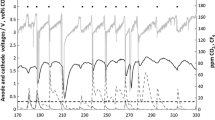Abstract
The commercial production of rare earth metals by fused salt electrolytic methods is described. These methods are used to make mischmetal, cerium, lanthanum, and didymium (Nd + Pr). The feed materials consist essentially of anhydrous chlorides of the metal to be produced, augmented by additions of nonrare earth salts to yield an electrolyte with satisfactory properties for reduction. The rare earths are derived either from monazite or from bastnasite ores. The anhydrous chlorides are manufactured from the hydrated chlorides by methods which minimize oxidation or hydrolysis. Alternatively, anhydrous chlorides may be used which result from the direct chlorination of rare earth ores by the Gold-schmidt process. These are particularly suitable for electrolysis due to their very low oxychloride content. Fluorides and oxides of the rare earths are produced by wet chemical methods to provide the relatively small quantities of these compounds now used for commercial fused salt electrolysis. Reduction cells in use today are constructed mainly from a) ceramics, b) graphite, or c) iron. The advantages and disadvantages of these types of cells are described together with the typical products which result from their use. Primary attention is given to production of mischmetal (mixed rare earth metal), which is the rare earth metal produced on the largest scale today. Brief reference is made also to production of cerium, lanthanum, and didymium (Nd + Pr) metal. Finally, a resume of the current uses of these metals is presented with reference to recent trends in the industrial applications of the rare earth metals.
Similar content being viewed by others
References
P. M. J. Gray: Trans. Inst. Min. Met., vol. 61, p. 141, London, 1951–2.
T. A. Henrie, Journal of Metals, vol. 16, p. 12, 1964.
J. A. Livingston: FIAT Final Report No. 909 1946.
F. Matthes et al: Chem. Techn., vol. 14, p. 3, 1962.
E. Morriee et al.: USBM-RI 5868, 1961.
E. Morrice et al.: USBM-RI 6075, 1962.
E. S. Shedd et al.: USBM-RI 6362, 1964.
E. S. Shedd et al.: USBM-RI 6882, 1966.
R. Singer et al.: B.I.O.S. Final Report No. 400, 1945.
Author information
Authors and Affiliations
Rights and permissions
About this article
Cite this article
Hirschhorn, I.S. Commercial production of rare earth metals by fused salt electrolysis. JOM 20, 19–22 (1968). https://doi.org/10.1007/BF03378677
Published:
Issue Date:
DOI: https://doi.org/10.1007/BF03378677




